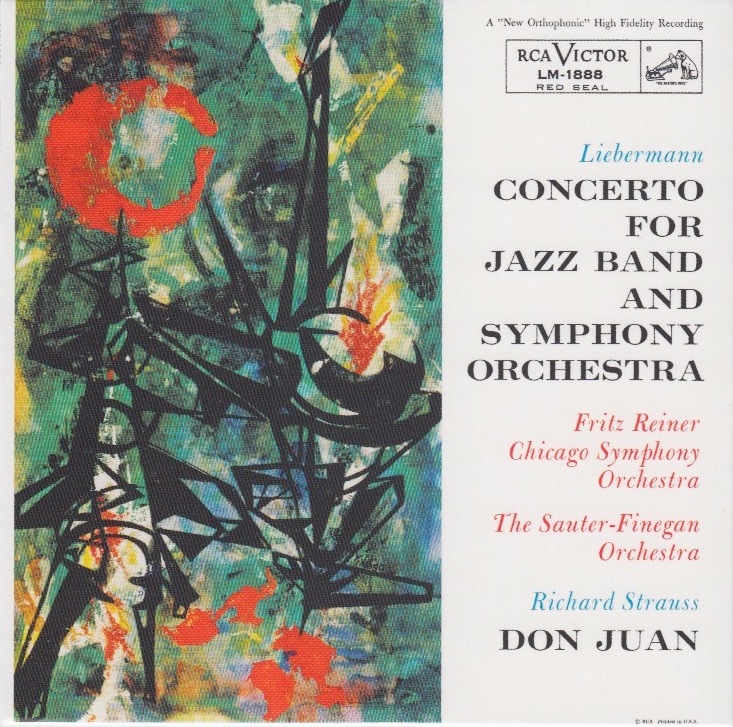
Now, today’s listening fare is an interesting pairing: Rolf Liebermann’s Concerto for Jazz Band and Symphony Orchestra and Richard Strauss’ Don Juan.
And what I find is a really big hoot is the copy on the back of the album. Headline (in big, bold letters): Long Hairs, Hepcats – Dig That Crazy Combo.
Hepcats?
Setting up my listening station outside on the screen-in porch, rain gently falling (hopefully giving my wife’s flowers enough of a drink that I don’t have to water them myself), I sat down to experience another Jazz composition from the 1950s (I’m a big fan of Dave Brubeck’s Time Out album, which was released in 1959).

The first thing I want to know is this: Who is Rolf Liebermann? And what was The Sauter-Finegan Band?
For the answer to those burning questions (which are – as I’ve noted before – the reason why I undertake these musical explorations from time to time: I love to learn), I turn to Wikipedia.
First, for Rolf Liebermann,
Rolf Liebermann (14 September 1910 – 2 January 1999), was a Swiss composer and music administrator. He served as the Artistic Director of the Hamburg State Opera from 1959–1973 and again from 1985–1988. He was also Artistic Director of the Paris Opera from 1973–1980.
Liebermann was born in Zürich, and studied composition and conducting with Hermann Scherchen in Budapest and Vienna in the 1930s, and later with Wladimir Vogel in Basel. His compositional output involved several different musical genres, including chansons, classical, and light music. His classical music often combines myriad styles and techniques, including those drawn from baroque, classical, and twelve-tone music.
Groovy, man.

And now, for The Sauter-Finegan Band,
The orchestra was led by Eddie Sauter and Bill Finegan, who were both experienced big band arrangers. Sauter played mellophone, trumpet, and drums, and had attended Columbia University and Juilliard; Finegan had studied at the Paris Conservatory. They began recording together in 1952, using inventive arrangements that made use of a variety of unusual instruments, including many orchestral instruments as well as oddities like the kazoo and the beaten human chest.
A June 7, 1952, article in the trade publication Billboard described the new group as “a creative band, which will combine dance music as well as mood interpretations.”
The group initially had a three-year contract with RCA Victor, with plans “for about 16 sides a year.”
Now that was interesting.
Frankly, I liked The Sauter-Finegan Band’s music for long hairs and hepcats more than I liked Richard Strauss’ Don Juan, another tone poem.
For background, I turn once again to Kenneth Morgan’s book Fritz Reiner Maestro & Martinet, page 56:
…three works received their American premiere under Reiner in Chicago:…and Rolf Liebermann’s Concerto For Jazz Band and Symphony Orchestra. The latter was a novelty, an unusual union of jazz band and symphony orchestra. It consisted of a twelve-tone concerto that incorporated three classical jazz forms – the jump, the blues, and boogie-woogie – and ended with a rousing mambo. It was played by the full Chicago Symphony Orchestra with the Sauter-Finegan Band.
The ending – what Morgan referred to as “a rousing mambo” – reminded me of something by Argentine-American composer Lalo Schifrin. The Jazz band combined with the symphony orchestra, playing “a rousing mambo,” sounded like the theme to Mannix, which Schifrin composed. I don’t mean the melody is the same. But the spirit of it is reminiscent of a 1960s TV theme song.
As for Don Juan, I’ll turn to is entry on Wikipedia, where I discover this:
The Objective Stuff
Rolf Liebermann (1910-1999). Richard Strauss (1864-1949). Fritz Reiner (1888-1963). Lalo Schifrin (1932- ). Eddie Sauter (1914-1981). Bill Finegan (1917-2008). This was recorded at Orchestra Hall on December 6, 1954, on the RCA Victor Red Seal label using the “New Orthophonic” system. Richard Strauss composed the tone poem Don Juan (Op. 20 in E Major) in 1888. He was 24.
The Subjective Stuff
Recording quality: 5
Overall musicianship: 5
CD book notes: 3
CD “album cover” information: 3
How does this make me feel: 4
This CD is two different compositions, two different performances. So it’s hard to “rate” the thing overall.
Of the two performances, I preferred the first one. Maybe I’m a hepcat. But I liked the energy and the novelty of it. It was swingin’, man.
What I find interesting is that these two performances, from what I can glean from the meager liner notes, were recorded in the same day. That’s an interesting tidbit that I wish someone would have expanded on. For example, what did Fritz Reiner – who, by most accounts, was a tightly wound fella with a baton – think of “that crazy combo,” The Sauter-Finegan Band? Did Reiner like the music? And how did he switch gears from a Jazz performance to a straight Classical one (or vice versa)? For that matter, which performance happened first?
I would love to know how that day went for the CSO, Reiner, and “that crazy combo.”
I wholeheartedly recommend this album, if for no other reason than to hear the first performance. That juxtaposition of a tightly wound fella with a baton and something so energetic and swinging would have been a sight to see that winter day in 1954.
